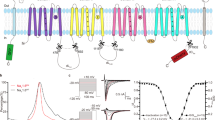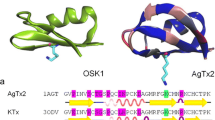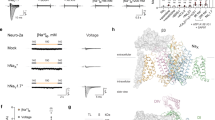Abstract
In this work molecular modeling was applied to generate homology models of the pore region of the Na v 1.2 and Na v 1.8 isoforms of human voltage-gated sodium channels. The models represent the channels in the resting, open, and fast-inactivated states. The transmembrane portions of the channels were based on the equivalent domains of the closed and open conformation potassium channels KcsA and MthK, respectively. The critical selectivity loops were modeled using a structural template identified by a novel 3D-search technique and subsequently merged with the transmembrane portions. The resulting draft models were used to study the differences of tetrodotoxin binding to the tetrodotoxin-sensitive Na v 1.2 (EC50: 0.012 μM) and -insensitive Na v 1.8 (EC50: 60 μM) isoforms, respectively. Furthermore, we investigated binding of the local anesthetic tetracaine to Na v 1.8 (EC50: 12.5 μM) in resting, conducting, and fast-inactivated state. In accordance with experimental mutagenesis studies, computational docking of tetrodotoxin and tetracaine provided (1) a description of site 1 toxin and local anesthetic binding sites in voltage-gated sodium channels. (2) A rationale for site 1 toxin-sensitivity versus -insensitivity in atomic detail involving interactions of the Na v 1.2 residues F385-I and W943-II. (3) A working hypothesis of interactions between Na v 1.8 in different conformational states and the local anesthetic tetracaine.

Tetracaine in complex with Nav1.8 in fast-inactivated form. The ligand is represented in CPK and colored by atom type. Ribbons and amino acids are colored by domain: yellow = domain I, blue = domain II, green = domain III, red = domain IV, pink = inactivation gate. Main interaction partners are shown in CPK. a) Tetracaine bound to the inner vestibule. View along the membrane plane. b) Same view as in a but limited to main interaction partners only. The polar head group of tetracaine interacts with the DEKA-motif residues, its hydrophobic tail with the hydrophobic and mainly aromatic residues of S6-IV and the inactivation gate





Similar content being viewed by others
References
Catterall WA (2000) Neuron 26:13–25
Hille B (2001) Ion channels of excitable membranes. Sinauer Associates Inc, Sunderland, MA USA
Sato C, Ueno Y, Asai K, Takahashi K, Sato M, Engel A, Fujiyoshi Y (2001) Nature 409:1047–1051
Ragsdale DS, McPhee JC, Scheuer T, Catterall WA (1994) Science 265:1724–1728
Ragsdale DS, McPhee JC, Scheuer T, Catterall WA (1996) Proc Natl Acad Sci USA 93:9270–9275
Linford NJ, Cantrell AR, Qu Y, Scheuer T, Catterall WA (1998) Proc Natl Acad Sci USA 95:13947–13952
Wang GK, Quan C, Wang S (1998) Pflugers Arch 435:293–302
Wright SN, Wang SY, Wang GK (1998) Mol Pharmacol 54:733–739
Nau C, Wang SY, Strichartz GR, Wang GK (1999) Mol Pharmacol 56:404–413
Sunami A, Glaaser IW, Fozzard HA (2000) Proc Natl Acad Sci USA 97:2326–2331
Yarov-Yarovoy V, Brown J, Sharp EM, Clare JJ, Scheuer T, Catterall WA (2001) J Biol Chem 276:20–27
Yarov-Yarovoy V, McPhee JC, Idsvoog D, Pate C, Scheuer T, Catterall WA (2002) J Biol Chem 277:35393–35401
Vassilev PM, Scheuer T, Catterall WA (1988) Science 241:1658–1661
Stuhmer W, Conti F, Suzuki H, Wang XD, Noda M, Yahagi N, Kubo H, Numa S (1989) Nature 339:597–603
Patton DE, West JW, Catterall WA, Goldin AL (1992) Proc Natl Acad Sci USA 89:10905–10909
West JW, Patton DE, Scheuer T, Wang Y, Goldin AL Catterall WA (1992) Proc Natl Acad Sci USA 89:10910–10914
Penzotti JL, Fozzard HA, Lipkind GM, Dudley Jr SC (1998) Biophys J 75:2647–2657
Lipkind GM, Fozzard HA (1994) Biophys J 66:1–13
Guy HR, Durell SR (1996) Developing three-dimensional models of ion channel proteins. In: Narahashi T (ed) Ion Channels, vol 4. Plenum, New York, London, pp 1–40
Guy HR, Durell SR (1995) Structural model of Na+, Ca2+, and K+ channels. In: Dawson D (ed) Ion channels and genetic diseases. The Rockefeller University Press, New York, pp 1–16
Jiang Y, Lee A, Chen J, Cadene M, Chait BT, MacKinnon R (2002) Nature 417:515–522
Jiang Y, Lee A, Chen J, Cadene M, Chait BT, MacKinnon R (2002) Nature 417:523–526
Doyle DA, Morais Cabral J, Pfuetzner RA, Kuo A, Gulbis JM, Cohen SL, Chait BT, MacKinnon R (1998) Science 280:69–77
Lipkind GM, Fozzard HA (2000) Biochemistry 39:8161–8170
Khan A, Romantseva L, Lam A, Lipkind G, Fozzard HA (2002) J Physiol 543:71–84
Tikhonov DB, Zhorov BS (2005) Biophys J 88:184–197
Guex N, Peitsch MC (1997) Electrophoresis 18:2714–2723
Teplyakov A, Obmolova G, Badet-Denisot MA, Badet B, Polikarpov I (1998) Structure 6:1047–1055
van Gunsteren WF, Billeter SR, Eising AA, Hünenberger PH, Krüger P, Mark AE, Scott WRP, Tironi IG (1996) Biomolecular Simulation: The GROMOS 96 Manual and User Guide. vdf Hochschulverlag AG an der ETH Zürich, Zürich
Rohl CA, Boeckman FA, Baker C, Scheuer T, Catterall WA, Klevit RE (1999) Biochemistry 38:855–861
Laskowski RA, MacArthur MW, Moss DS, Thornton JM (1993) J Appl Cryst 26:283–291
McMartin C, Bohacek RS (1997) J Comput Aided Mol Des 11:333–344
Fozzard HA, Lipkind G (1996) Jpn Heart J 37:683–692
Hille B (1971) J Gen Physiol 58:599–619
Hille B (1975) Biophys J 15:615–619
Guo XT, Uehara A, Ravindran A, Bryant SH, Hall S, Moczydlowski E (1987) Biochemistry 26:7546–7556
Noda M, Suzuki H, Numa S, Stuhmer W (1989) FEBS Lett 259:213–216
Ravindran A, Moczydlowski E (1989) Biophys J 55:359–365
Terlau H, Heinemann SH, Stuhmer W, Pusch M, Conti F, Imoto K, Numa S (1991) FEBS Lett 293:93–96
Doyle DD, Guo Y, Lustig SL, Satin J, Rogart RB, Fozzard HA (1993) J Gen Physiol 101:153–182
Elliott AA, Elliott JR (1993) J Physiol 463:39–56
Gallivan JP, Dougherty DA (1999) Proc Natl Acad Sci USA 96:9459–9464
Hille B (1977) J Gen Physiol 69:497–515
Vedantham V, Cannon SC (1999) J Gen Physiol 113:7–16
Scheuer T (1999) J Gen Physiol 113:3–6
Noda M, Ikeda T, Kayano T, Suzuki H, Takeshima H, Kurasaki M, Takahashi H, Numa S (1986) Nature 320:188–192
Akopian AN, Sivilotti L, Wood JN (1996) Nature 379:257–262
Choudhary G, Yotsu-Yamashita M, Shang L, Yasumoto T, Dudley Jr SC (2003) Biophys J 84:287–294
Huheey JE, Keiter EA, Keiter RL (1993) Inorganic chemistry: principles of structure and reactivity. Harper Collins, New York
Allen TW, Andersen OS, Roux B (2004) Proc Natl Acad Sci USA 101:117–122
Acknowledgements
HS thanks the Swiss Institute of Bioinformatics for support of this work. He also thanks GlaxoSmithKline for generous travel grants and a modified version of SPDBV.
Author information
Authors and Affiliations
Corresponding author
Rights and permissions
About this article
Cite this article
Scheib, H., McLay, I., Guex, N. et al. Modeling the pore structure of voltage-gated sodium channels in closed, open, and fast-inactivated conformation reveals details of site 1 toxin and local anesthetic binding. J Mol Model 12, 813–822 (2006). https://doi.org/10.1007/s00894-005-0066-y
Received:
Accepted:
Published:
Issue Date:
DOI: https://doi.org/10.1007/s00894-005-0066-y




